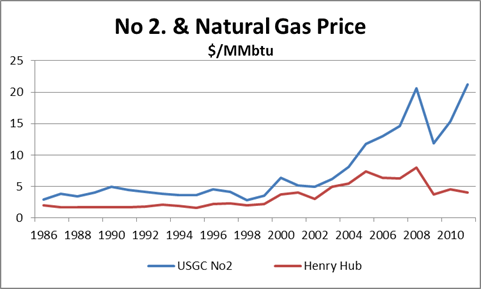AEO 2012 Natural Gas Liquids (NGL) & Condensates: Glut of Supply
This blog is adding on top of our previous blog, discussing the latest release of the Annual Energy Outlook 2012 (AEO 2012) by the Energy Information Agency (EIA). Shale gas revolution encompasses not only natural gas, but a glut of liquids from condensates to natural gas liquids (NGL). Shale gas is not only impacting the natural gas markets, but has and will impact the chemicals and refining markets. The AEO 2012 shows an increase of only ~600 kbd of NGL from 2010 to 2020. This is a very conservative number. In terms of condensate, the AEO does not break it out, but crude oil and condensates grow only 1.3 mmbpd. In the write up, much of the growth is a function of tight oil not condensates. Once again, I believe this to be almost too conservative.
In order to justify this stance, one can examine the many recent assessments done by the USGS. Adding up just the Eagle Ford, Marcellus, and Permian assessments; the mean NGL technically recoverable volumes total over 6 billion barrels. According to USGS, they have places the condensates into the NGL category. Liquids are clearly driving the shale gas production. Gas is almost becoming a loss leader. As I discussed in my previous blog, there are multiple projects focused on expanding the infrastructure in order to monetize the NGLs coming from these shale plays. One of my estimates of NGL and condensate additional volumes for 2020 compared to 2010 would be an increase of 2 mmbpd.
With this much volume of light feedstock, the US refining markets will see a drastic change. A historical given was the crude slate was going to get heavier requiring more and more conversion capacity. With the amount of NGL and condensates, the US market could potentially see a pause to this belief is inevitable if not a reversal from this trend. Much of the refining capacity has been designed to process heavy crudes not light feedstock. Refining margins from a highly complex refinery will not be pretty. Perhaps many have come to this thinking with all the refining closures and selling announcements. Simple condensate splitters economics would not bode well either, as a surplus in naphtha will likely occur. NGL and condensates will need to find a home. A re-configuration of existing refineries will come at significant losses to the current owners. There will be winners. Those who have access to capital and can think outside the box will win. The consumers will also be a big beneficiary of refining margin compression.
We positively and evocatively challenge the current thinking involving any aspect of energy use. We look for projects that offer meaningful, transformative, with impactful outcome to the marketplace or society.
Independent analysis and opinions without a bias is what we offer to our clients. Please consider and contact All Energy Consulting when you need consulting services.
Your Energy Consultant,
EIA Annual Energy Outlook AEO 2012 Points of Interest
Each year when the EIA releases their Annual Energy Outlook AEO, there is much talk about the results. The problem I find each year is trying to understand the change in the relationships between various markets. This is a function of the underlying model they are using. They are using the NEMS model which uses a general equilibrium concept. Personally, I never felt modeling should be left to the model. General equilibrium models are very dependent on all the experts to enter the relationships. Then the model will model those relationships. However, if you don’t have an expert of all things, the model may produce interesting relationship changes; since these experts are experts without integration.
My quick review focused on the Natural Gas, Coal, and Distillate: This is largely because the power market comingles these fuels, therefore, these relationships should be acted upon by the power market. Below are the gas price comparisons to coal and distillate deltas to the 2011 AEO deltas.
AEO 2012 decided in this year’s outlook that the oil spread to gas will be larger than last years by over $5/MMbtu. The gas to coal spread will decline by $0.30/MMbtu. This is largely a result of coal prices being stronger than gas prices being weaker.
Given these relationships before examining the consumption numbers, I would believe that more gas will be in the power sector. Coal use should decline. There should be some gas to liquids (GTL) at some point given the large economic incentive.
The consumptions on a high level show coal consumption being 10% less – no surprise there. However, total gas consumption is essentially the same as last year’s AEO 2011. Digging deeper the power sector use of natural gas climbs over 12% from last year’s AEO. Where is the demand for gas falling to keep the totals the same? It would seem the EIA has a more bearish outlook for natural gas use in the industrial sector and commercial sector. The commercial sector falls 7% which perhaps can be accounted for by efficiency improvements. Industrials seem counter intuitive given the many chemical projects recently announced.
Coal to liquids (CTL) demand fell by half, directionally correct since coal prices are higher but certainly not to the degree that liquid prices are higher. Interesting to see no gas to liquid (GTL) demand. I understand the complexity of GTL (I have a BS Chemical Engineering degree from the University of Texas). Numerous reports suggest GTL likely many years out. However all those reports were written when gas and oil were much closer to parity in the United States.
In addition, the driver for GTL was for stranded gas not in the US. The US innovative market structure plus the sustained large spread between gas and oil should lead to GTL development. My skepticism in GTL lies in the premise the spread will be that large for such a sustained time period. Based on my assessment, the amount of natural gas usage in the power sector is still too low by around 20%. It would be hard press to maintain the coal fleet as it ages with gas prices below $5/MMbtu for the next 10 years. In terms of balancing capital and environmental risk, no other form of generation can beat natural gas for baseload demand across the country. New coal units cannot compete with new natural gas plants with gas-coal spreads less than $3/MMbtu. Around $3/MMbtu, it is marginable and when considering the CO2 risk, it would take spreads closer $4/MMbtu+. Commissions approving coal plants in this environment are typically incorporating other unrelated energy economics (e.g. local jobs, resources). The only thing that haunts natural gas is the price spike seen in 2005-2008. However, if you think about the catalyst that drove that price rise, hurricane Katrina, it becomes less likely to vision in the future. Shale gas has created another layer of gas in the supply curve, which is less sensitive to gulf coast storms.
Further analysis of the AEO is warranted. A certain credit must be given to them for being the pundit willing to go out on the limb and supply every bit of information. I don’t usually agree with the EIA forecast, but they have made great strides in their forecasting ability. They have incorporated more reasonable capital cost projections. They are a good benchmark for modeling. We can only wish other countries around the world would emulate the EIA in supplying historical information and estimated forecast figures.
Market assessments and market forecasting are one of our specialties.
We positively and evocatively challenge the current thinking involving any aspect of energy use. We look for projects that offer meaningful, transformative, with impactful outcome to the marketplace or society (see projects).
Please consider All Energy Consulting for your consulting needs.
Your Energy Consultant,
Gasoline Prices for Next Year
Repost from my other blog with an updated note.
One of the most common questions I get asked by my friends is “What will be the price of gasoline?”
I have this rule of thumb that I learned by observation – I never really tested the theory till now. The rule I tell my friends just take the average of 4th quarter price of gasoline and you can expect the peak price in the driving season to be around 70 cents/gallon higher.
Once again with the magic of the Internet one can test that rule of thumb. I went back from 2010 to 2000 and discovered the US Gulf Coast (USGC) December average subtracted by the peak of next year driving season averaged 76 cents/gallon. Over the last five years the min was 40 cents/gallon and the max was 1.70 cents/gallon. Now of course my friends are focused on the retail price so I say if you are looking at the wholesale price you need to add another 70 cents/gallon to get to retail.
Clearly gasoline and the crude oil markets are seasonal. What I find really funny is the politicians and economist touting how petroleum prices were down over the last few months. Relative to last year our 4Q average YTD gasoline price is up by almost 30% – 58 cents/gallon. This does not bode well for next years driving season nor the economy. We could very likely see $4/gallon pump prices next year given the current prices.
Added note – beyond the simple seasonal demand trend of gasoline, prices also move up due to the cost to produce gasoline goes up. Gasoline blend changes in the summer time. This blend reduces the Reid Vapor Pressure (RVP) of the gasoline which makes it less likely to evaporate. Typically summer gasoline will have less butane which is more cost effective than other components that make up gasoline.
I can help you forecast any commodity through a fundamental approach of supply/demand and finding cross market dynamics. Please do keep All Energy Consulting in mind for your consulting needs. Let us write you a proposal.
Your Energy Consultant,





